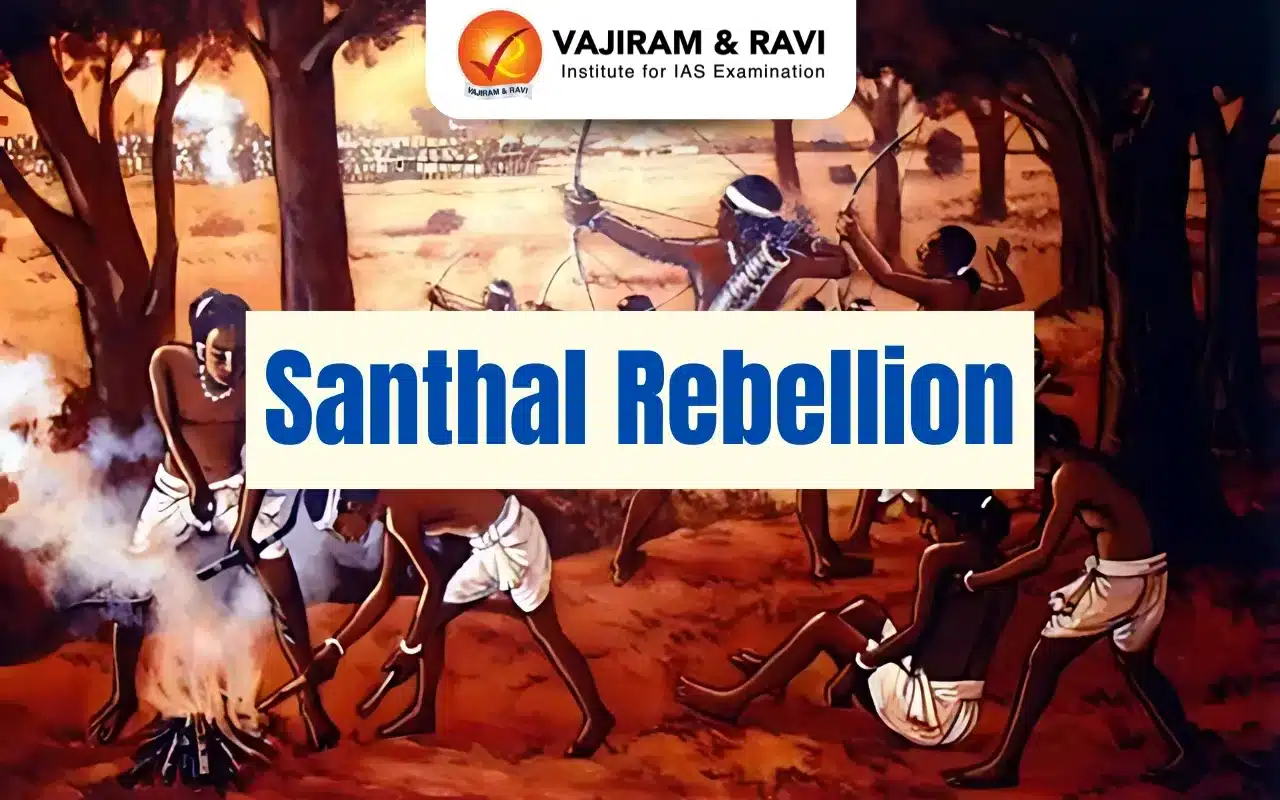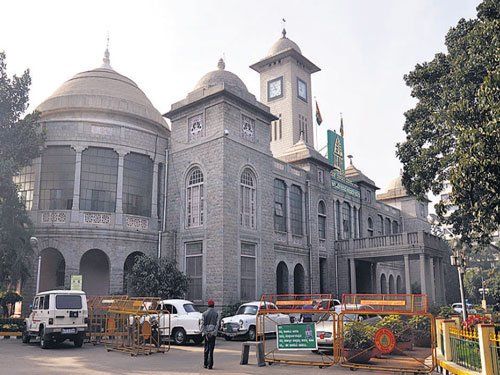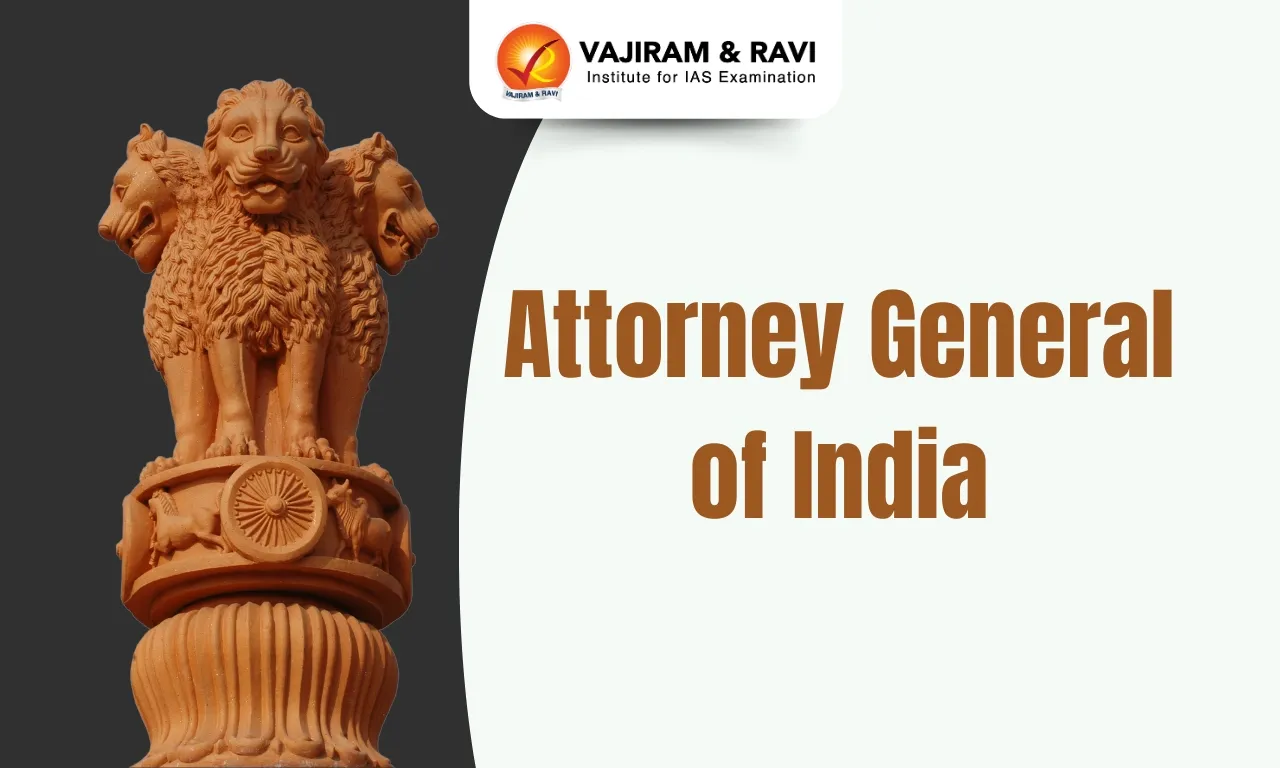The Santhal Rebellion (1855-1856), also known as the Santhal Hul, was one of the most significant tribal uprisings against British rule in India. Led by Sidhu and Kanhu Murmu, it originated in the Santhal Parganas, an area now part of modern-day Jharkhand. This rebellion marked a critical moment in the history of India’s freedom struggle.
The Santhal Rebellion was a response to the exploitation and oppression faced by the Santhals at the hands of the British authorities and their collaborators, including moneylenders (mahajans), landlords (zamindars), and corrupt officials.
Santhal Rebellion Background
The Santhal Rebellion (1855-1856) was driven by severe social and economic exploitation faced by the Santhals, a primarily agrarian tribal group. Encouraged by the British to settle in the Rajmahal foothills to boost agricultural revenue, the Santhals clashed with the Paharias over land. While the Santhals embraced settled farming, the Paharias relied on shifting cultivation, leading to a long-standing feud.
- The British attempted to mediate by creating Damin-i-Koh in 1832-33, allocating land to the Santhals.
- Over time, British policies and the exploitation by Zamindars and moneylenders deprived the Santhals of their land and pushed them into deeper poverty.
The resulting tension culminated in the Santhal Rebellion, marking a pivotal uprising against British colonial rule.
Who were the Santhal Tribes?
The Santhals were one of the largest tribal communities in India, predominantly residing in the states of Jharkhand, Bihar, West Bengal, and Odisha. They were known for their rich cultural heritage, distinct language (Santhali), and deep connection to the land they inhabited.
- Traditionally, the Santhals had been agriculturists, depending on the land for their livelihood. Their spiritual practices were closely linked to their agricultural lifestyle.
- The Santhal community had a strong social structure, with their society being organised into various clans known as 'parhas.'
- They followed animism, a belief system deeply rooted in nature worship. They honoured spirits associated with the earth, water, and forests.
Santhal Rebellion Causes
The Santhal Rebellion, which erupted in 1855, was driven by widespread discontent among the Santhal tribes over landlords' and colonial officials' exploitative practices. Grievances over land rights, oppressive revenue systems, and economic exploitation fueled the rebellion.
- Land Alienation: The British introduced the Permanent Settlement, which disrupted the Santhals' traditional land ownership. Their lands were taken by zamindars and moneylenders, who imposed heavy taxes, trapping them in debt and poverty.
- Economic Exploitation: Santhals faced exploitation by moneylenders who charged high interest rates, and they were often tricked into signing contracts they didn’t understand, losing their land and livelihood.
- Forced Labour: The British and local landlords forced Santhals to work under harsh conditions without fair pay, increasing their resentment.
- Barter System: Santhals relied on barter but struggled to pay taxes in cash, forcing them to borrow from moneylenders and trapping them in debt.
- Corruption and Oppression: Corrupt officials exploited the Santhals with unjust practices, pushing them towards rebellion.
Santhal Rebellion Events
The Santhal Rebellion was marked by a series of significant events that unfolded between 1855 and 1856. On June 30, 1855, under the leadership of Sidhu and KanhuMurmu, the Santhals declared their revolt against the British. They gathered at Bhognadih village and took an oath to fight against oppression. The declaration marked the beginning of the Santhal Hul.
- Mobilisation: The Santhals, led by Sidhu and Kanhu Murmu, declared the area between Bhagalpur and Rajmahal autonomous and sent messages to rally support.
- Initial Successes: The Santhals used guerrilla tactics, targeting zamindars and moneylenders, achieving early victories and capturing areas.
- British Retaliation: As the rebellion grew, the British rule in India imposed martial law, sending troops to suppress the Santhals brutally. Many villages were burned, and thousands were killed.
- Capture of Leaders: By January 1856, the rebellion was crushed, and key Santhal leaders like Kanhu Manjhi were captured, though some resistance continued.
Santhal Rebellion Outcomes
The Santhal Rebellion had profound outcomes, both immediate and long-term, significantly altering British administrative and military strategies in India. These outcomes include:
- Santhal Parganas: In response to the Santhal Rebellion, the British created Santhal Parganas in 1856, carving it out of Bhagalpur and Birbhum districts with special laws for the Santhal tribes.
- A new police system was introduced to eliminate intermediaries and encourage tribal cooperation in maintaining law and order. However, pressure from Zamindars and Indigo planters led to Act X of 1857, reducing protections for the Santhals.
- The Santhal Parganas Tenancy Act of 1876 aimed to safeguard Santhal land rights and prevent transfers to non-tribals, acknowledging their traditional land tenure.
Despite these measures, British repression increased, with stricter control over tribal areas and new laws to prevent future uprisings.
Santhal Rebellion Leaders and Participation
The Santhal Rebellion was characterised by widespread participation from the Santhal community, with both men and women playing active roles in the struggle. The Murmu brothers, Sidhu and Kanhu, led the rebellion, emerging as charismatic and fearless leaders.
- Sidhu Murmu: Sidhu was one of the principal leaders of the rebellion. Sidhu played a key role in organising the initial stages of the rebellion and leading the Santhals in battle.
- Kanhu Murmu: Kanhu, Sidhu's younger brother, shared leadership responsibilities with Sidhu and was instrumental in planning and executing the attacks against the British and their collaborators.
- Chand and Bhairav Murmu: The other two brothers, Chand and Bhairav, also supported Sidhu and Kanhu in their efforts to organise the rebellion and lead the Santhals in battle.
- Phulo and Jhano Murmu: Phulo and Jhano Murmu, the sisters of Sidhu and Kanhu, participated in the rebellion and are said to have entered the enemy camp undercover and killed several soldiers before they died.
Santhal Rebellion Significance
The Santhal Rebellion (1855-1856) stands as a pivotal event in the history of India's resistance against British colonial rule, particularly in the context of tribal movements. The significance of the Santhal Rebellion can be examined from several perspectives:
- Assertion of Tribal Identity and Rights: The Santhal Rebellion marked an important assertion of tribal identity, rights, and autonomy. The Santhals used the rebellion to voice their discontent and fight for their land, culture, and dignity.
- Inspiration for Future Tribal Movements: The Santhal Rebellion inspired future tribal and peasant movements in India. It highlighted the resilience and courage of tribal communities in the face of oppression and exploitation.
- Impact on Colonial Policies: The rebellion had a direct impact on British colonial policies toward tribal areas. In response to the uprising, the British government created the Santhal Parganas district in 1856, which aimed to provide a degree of autonomy and better governance for the Santhals.
Why was the Santhal Rebellion Different from Other Movements?
The Santhal Rebellion was distinct from other contemporary movements in several key ways. Unlike other uprisings led by elites or princes, the Santhal Rebellion was fully led by the tribal community, with leaders like Sidhu and Kanhu Murmu emerging from within, making it a grassroots movement.
- Mass Mobilization and Unity: The rebellion saw men, women, and children united in the fight against the British, creating a rare level of unity that made it stand out from other revolts.
- Use of Weapons and Tactics: Despite using simple bows and arrows, the Santhals' guerrilla tactics gave them an advantage over the British in Bihar.
- Cultural and Religious Dimensions: The Santhals saw the rebellion as not just a political fight but a defence of their culture and religion, with spiritual leaders calling for divine support.
- Successful Movement: Although defeated, the rebellion led to the Santhal Parganas Tenancy Act, which protected the tribes and sparked nationalist feelings.
Santhal Rebellion UPSC PYQs
Question 1: After the Santhal Uprising subsided, what were the measures taken by the colonial government? (UPSC Prelims 2018)
- The territories called 'Santhal Parganas' were created.
- It became illegal for a Santhal to transfer land to a non-Santhal.
Select the correct answer using the code given below:
(a) 1 only
(b) 2 only
(c) Both 1 and 2
(d) Neither 1 nor 2
Ans: (c)
Question 2: Which of the following provided a common factor for tribal insurrection in India in the 19th century? (UPSC Prelims 2011)
(a) Introduction of a new system of land revenue and taxation- of tribal products
(b) Influence of foreign religious missionaries in tribal areas
(c) Rise of a large number of money lenders, traders and revenue farmers as middlemen in tribal areas.
(d) The complete disruption of the old agrarian order of the tribal communities
Ans: (d)
| Other Related Articles | |
| Birsa Munda | Rani Gaidinliu |
| Munda Rebellion | Kol Uprising |
| Santhal Rebellion | Tribal Movements in India |
Last updated on December, 2025
→ Check out the latest UPSC Syllabus 2026 here.
→ Join Vajiram & Ravi’s Interview Guidance Programme for expert help to crack your final UPSC stage.
→ UPSC Mains Result 2025 is now out.
→ UPSC Notification 2026 is scheduled to be released on January 14, 2026.
→ UPSC Calendar 2026 is released on 15th May, 2025.
→ The UPSC Vacancy 2025 were released 1129, out of which 979 were for UPSC CSE and remaining 150 are for UPSC IFoS.
→ UPSC Prelims 2026 will be conducted on 24th May, 2026 & UPSC Mains 2026 will be conducted on 21st August 2026.
→ The UPSC Selection Process is of 3 stages-Prelims, Mains and Interview.
→ UPSC Result 2024 is released with latest UPSC Marksheet 2024. Check Now!
→ UPSC Prelims Result 2025 is out now for the CSE held on 25 May 2025.
→ UPSC Toppers List 2024 is released now. Shakti Dubey is UPSC AIR 1 2024 Topper.
→ UPSC Prelims Question Paper 2025 and Unofficial Prelims Answer Key 2025 are available now.
→ UPSC Mains Question Paper 2025 is out for Essay, GS 1, 2, 3 & GS 4.
→ UPSC Mains Indian Language Question Paper 2025 is now out.
→ UPSC Mains Optional Question Paper 2025 is now out.
→ Also check Best IAS Coaching in Delhi
Santhal Rebellion FAQs
Q1. Who started the Santhal Rebellion?+
Q2. Who was the chief leader of the Santhal rebellion?+
Q3. What were the causes of Santhal rebellion?+
Q4. What was the result of the Santhal Hool?+
Q5. What were the main objectives of the Santhal rebellion?+
Tags: quest santhal rebellion

















